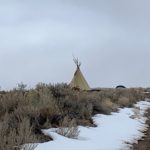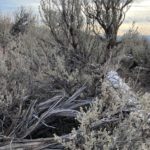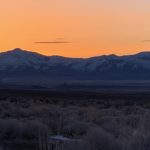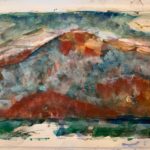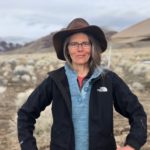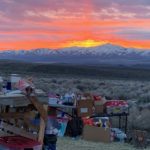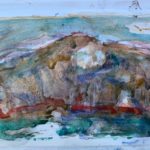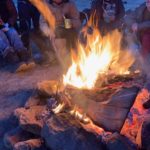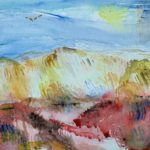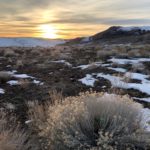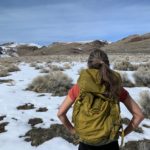Thacker Pass or “Peehee mm huh” to the Paiute tribe (translation = rotten moon).
After fifteen hours on the road, I arrive at the intersection of the place on a map and that place in my heart. I take a breath in. I am met with a warm welcome.
I know immediately that I am in the right place. The area is so remote. I am here at last. It is an hour north of Winnemucca, Nevada, not too far from the Oregon border. I drive past sand hills, a little rest area and one gas station in Orovada. I turn off and begin to follow other “landmarks” (power lines and dirt roads) to the BLM land—not clearly identifiable to me, but definitely known to others as the central site for Lithium Americas Corp. mining operation. I feel alive and abuzz and not sure what to expect—just that I feel called to come.
It is early March and winter winds and cold greet me brusquely. I ponder that I am out in the middle of Nevada wilderness because of a chance encounter with a now good friend I met on a beach in Santa Barbara two months earlier. My awareness about this part of the world started to unfold from there, and I have learned about Max Wilbert and Will Falk who have spearheaded the protest against this lithium mine—slated to the be the second in the United States. I must admit, I never gave a thought about where lithium comes from, and really how dependent on my cell phone and computer I have become. Max and Will have a website, protectthackerpass.org; have since hosted many podcasts; and keep updated a FB page for more up to date information on the scope of the project since occupying the site since January.
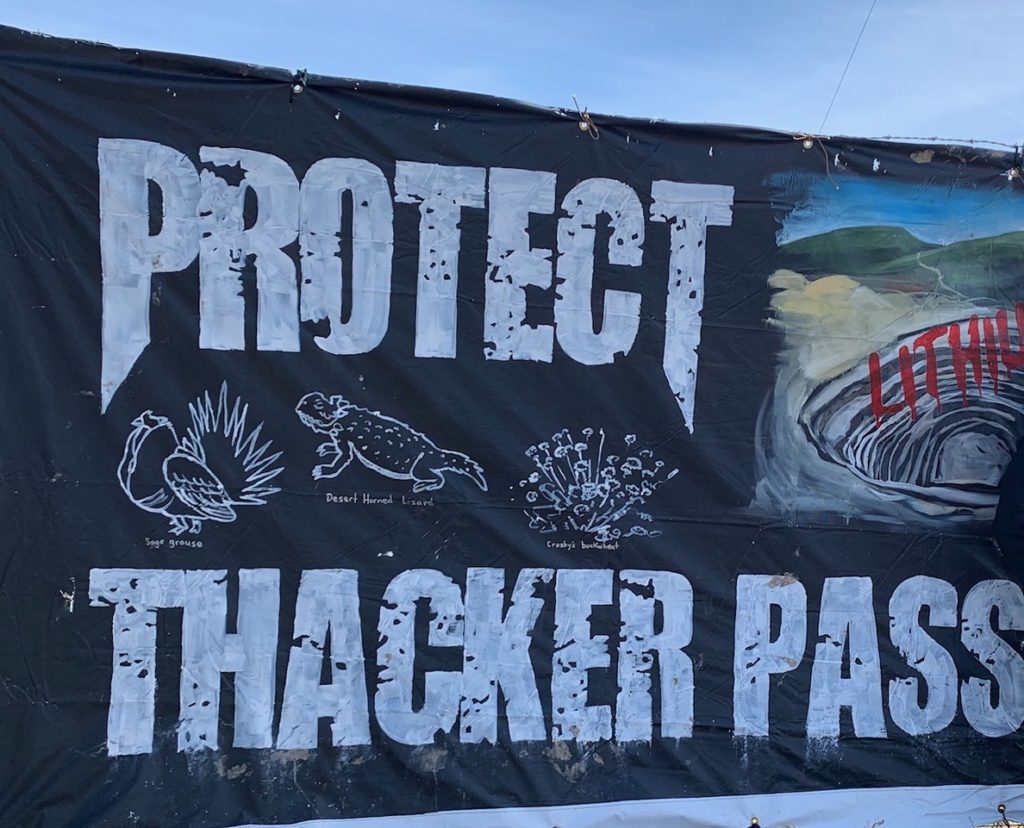
The extraction of lithium is being billed as “green” and Nevada, Elon Musk and the U.S. government are all excited about it. But that is not the full story. It is so complex. I wasn’t sure I wanted to delve deeper, but I am here to learn as much as I can. As difficult as it is for me to hear about the environmental implications, the operation is expected to provide jobs during construction and ongoing work for the local economy and meet the growing demand for renewable energy technology by mining green tech materials like lithium. But at what cost? How much lithium is actually needed? Do we even know? Time to ask some really hard questions.
The open pit mine has been awarded to a Canadian company called Lithium Americas, and they are set to start clearing 6,000 acres of land as soon as the ground thaws just a bit from a long winter, and they get five permits (four for water and one a “kill, harass and injure” permit which allows them to kill golden eagles if they are bothering the mining operation).
When $400 billion dollars can be raised in a single day to keep this project moving forward, it’s hard to imagine other comprehensive solutions will be entertained. If productive, there are already other claims to mining in the state and more and more land will be cleared to feed our consumption. The demand for electric cars is growing.
I’m told that the required environmental impact study was rushed through during COVID and that locals were not included in this process. Three years is what usually is required to assess feasibility. Mining at this scale seems anything but “green”. Water is needed to bring lithium to the surface, pumping up to 3,250 gallons per minute. Toxic water from the tailing waste facility contains high levels of mercury and arsenic and other contaminants. This will affect ground and surface water quality. And there will be air pollution with unknown amounts of sulphur dioxide emissions. The nearby and down stream/down wind farming communities are concerned about drought, climate change, and quality of life. The chemicals pose a threat for wildlife and people living in a 150 mile radius. This project will destroy critical habitat for endangered species of sage brush and sage grouse, golden eagles, cutthroat trout, and will disrupt deer migration. There must be truth and transparency and accountability for the inevitable costs of extracting minerals from the earth.
Once the production begins, this area will never be the same. Word is getting out because, although it is unrealistic that operations will be stopped, it is important to understand that the use of lithium in cell phones, computers and electric cars is driving this massive forty-six year future of petroleum trucks (carrying the sulphuric acid needed to extract the lithium—estimated at 5,800 tons daily) in and out of the area. Accidents are expected to happen and before rushing in to get the “white gold dust”, better confidence and accountability would soften the wounds of this kind of raw aggressive mining. I’m seeing the underbelly of a “green” project and it’s not pretty.
I see in my friend’s eyes how important this issue is to her. I roll up my sleeves and open my mind and try to better understand what is at stake. But as someone who needs to feel into it, I would need to not only read about the project, but actually go to the site and feel into it—walking on sacred tribal land.
I prefer a nomadic lifestyle these days, stumbling upon life in unexamined places. I am uncovering and discovering parts of the world and parts of myself in the process. I am open to going and trust in the timing because of the strong yes I feel in my body when I hear about the project. My schedule opens and dry roads are in the forecast so I jump in my car and off I go, heading west to learn about the area, the scope of the proposed lithium mine, and record my thoughts and feelings in artistic form. I feel a sense of purpose—a way to combine my love of nature, energy work, writing and painting. I am excited to be asked to record and share my observations.
The first thing I notice driving up to camp is a lone hawk circling above the sign that designates this as BLM land. I am told the sign just went up recently in response to new active opposition to the mine. As a little aside, that then means that protesters can spend no more than fourteen days in a twenty-eight day period or face a fine and/or jail time. No structures that could be considered permanent are permitted, including the makeshift kitchen and/or a port-a-potty. These are the very same rules that will be dismissed when activity begins. An eighty foot test pit has determined the place viable—the final depth for the 6,000 acres (two miles East of where I stand; 1/3 of the way up and into the mountain to the North, and 1/2 mile or so South to the main road; and to the West just past the road that I drove up on—a large footprint!) of the open pit mine will be 400 feet.
I bear left and pass a tipi, and I stop briefly to say hello and then continue further up for signs of friends and where to set up camp. I see a barbed wire enclosure with a tall weather indicator and solar panel inside. I pull up and park, placing wood under the tires of my Outback—concerned that if I didn’t I would be stuck in the very mud I fishtailed on in the middle of the day in the midday sun. This will be my camping spot for the next three days. My heart lies on the heart of the earth. The campfire that burns all day and night is next to the communal kitchen. Out of my car window at night, I will look up and out and reach upwards to a magnificent sparkling comforting blanket of stars—the promise of some warmth in the chilly nighttime hours.
A band of old growth sagebrush captures my attention. There is newer sagebrush around the campsite, but the old sage has a distinctive color and is beautiful. The land seems untouched for the most part. I walk a little off the dirt road and accidentally flush out a pair of sage grouse. I am startled into awareness that this land is anything but barren. I begin to look for more signs of life and get to know the area by exploring on foot and then I find rock outcroppings to sit on and take in the sight and the sounds. Dropping into the stillness and quiet helps orient me to the spirit of the place.
Later that afternoon, Paiute and Shoshone members gather around the campfire, and I take my place along side them. I pass out donuts and water and settle in to hear their stories in English and in their native tongue. These snippets of their history keep coming. They find a place in my heart. I listen, eager to hear and share in this oral tradition. I am struck by how they could account for all family members—everyone was a sister or an auntie and has their place in the lineage. I listened as they talked about the history of the area. An elder, Eddie, shares his grandmother’s teachings and what this land means to him; the battles that took place and blood shed, the medicine in the land, and how he uses the sage brush for illnesses, the caves, and sacred sites…the stories are clear and strong. And, like a blanket, they weave me into their world and wrap me in their warmth.
Sitting with the Shoshone and Paiute Elders, with great grandchildren playing at their feet, gives me a good idea of what they have experienced over time. They have survived a lot and know how to call on their ancestors through prayer and ritual. Many share the losses of their family members to cancer living downstream of the local mercury mines. No one has investigated the cancer incidence to date. Now they will again be downstream of the air and water toxins that will be produced from the lithium mines.
Sitting amongst the local tribes and listening to stories shared around the campfire, woven colorful blankets draped around the shoulders of the elders and on their laps reminding me of the orange sunsets and dark blue night skies, open me up to the complexities of how my way of being in the world is so connected to the land and people. It cannot be an “out of sight out of mind” mentality anymore. My comfort with life becomes a noticeable discomfort as I take in all I feel and see in that short time. What am I willing to give up and why should I? I will process that for awhile. Which tradeoffs are acceptable and which are not? I found out that the trip home was not enough space and time to do so.
Heart conversations like the ones I share with the Native Americans make sense that we come together to address mutual concerns for generations to come. That junction where environmental awareness and protection comes up against lifestyle choices. That is where the tension lies. It is also where hope lives.
I have returned full and energized to follow and to continue to support those who can participate in this conversation. There will be more gathering as word starts to get out and people become attuned to the deeper truths and can trust that this is the best way forward—not out of greed but out of love for one another. There is so much abundance in community.
I am, yes, part of the problem, but I can also be part of the solution. I expect to return and I expect to offer more support and supplies. Prayer walks are being organized. Fire ceremonies too. I hope for more beautiful, tender and heart felt interactions with the Indigenous communities. It is all so healing. And, I feel time is of the essence.

